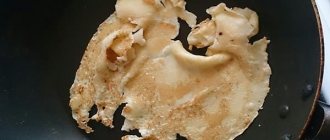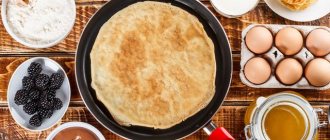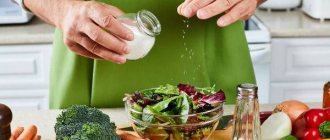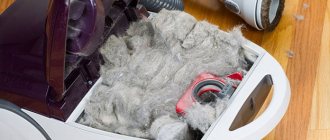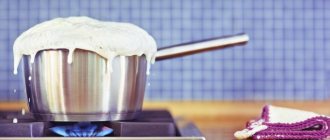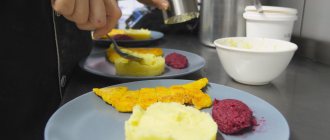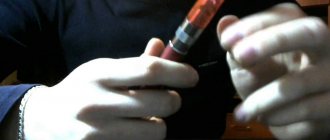Hi all! The first mentions of pancakes are found in the annals of the Egyptians. The dish was a sour flatbread baked on stones.
Over time, the method of preparing food and the list of necessary ingredients changed. Now, instead of stones, we have a frying pan, and you can find pancake recipes on the Internet for every taste: from thick salty to thin sweet.
Let's start with the pan in which you will cook the pancakes. It should have a thick bottom and low sides. The best option is cast iron or Teflon coated.
Turn the pancakes over only when they separate well from the pan. But, if everything is in order with your dishes, I suggest you consider other reasons why it is so difficult to get perfect pancakes.
What to do if pancakes tear when flipping
The problem may be that there aren't enough eggs in the pancake batter. Eggs give elasticity to the dough, their proteins form a network structure that binds liquid.
So try adding an egg to remedy the situation.
Or the products for making pancakes are of poor quality:
- tap water;
- stale eggs;
- rancid or old oil;
- stale fermented milk products;
- wholemeal flour.
I’ll say something about flour. Even modern food processing technologies are not about. And even in premium products you can find foreign debris (threads, a piece of paper, etc.). During long-term storage, flour cakes, its baking properties deteriorate, and lumps may form.
Therefore, be sure to sift the flour. Use a sieve or strainer. Then the flour will be saturated with oxygen, it will become more fluffy and loose, and, therefore, the pancakes will turn out much tastier and airier.
And the risk of them tearing when turned over will decrease.
Excess seasonings and spices can also disrupt the consistency of the dough.
Be careful when adding spices:
- vanilla;
- cinnamon;
- pepper;
- cardamom, etc.
Be sure to let the dough sit for 30-40 minutes. During this time, the base will acquire the necessary elasticity and pliability.
As a result, your products will be smooth, intact and beautiful.
But here it is also important to turn the pancakes correctly. On one side, the pancake should be lifted in a circle using a special spatula, and then, slightly lifted, carefully but quickly turned over.
Lack or excess of flour
So why do pancakes tear when flipped? It is almost impossible to give a definite answer. First of all, the taste and appearance of the product largely depends on the quality and quantity of ingredients used to prepare the dough.
One of the main components included in the dough for making pancakes is flour. Excessive amounts of it make the pancake mass excessively thick, as a result of which it cannot spread evenly and quickly over the surface of the pan. In this case, the cakes will turn out too thick, similar to hard pancakes.
Lack of flour will cause a batter. The rapid evaporation of moisture emanating from the steaming pancake layer makes it less elastic and elastic. As a result, during the frying process the cake has no choice but to tear when turned over. Therefore, it is necessary to add as much flour as indicated in the recipe. This is an important nuance that should not be neglected.
Why do pancakes stick to the pan and tear?
The first reason for sticking is a pan that is not well oiled.
If necessary, you can also add a little sunflower oil to the dough: for 1 liter of dough, 2-4 tbsp. spoons.
After all, excess oil will lead to separation of the dough, which can also cause the pancake to tear.
Do not cook thin pancakes over high heat. If the temperature is too high, they will burn and stick. Heat the frying pan, then reduce the heat and calmly cook your dish.
The third reason for sticking is the same eggs. Add another egg to the dough.
The fourth reason is excess sugar. During frying, the sugar caramelizes and burns, which can cause the pancake to stick to the pan and tear.
What's wrong with the frying pan?
Quite a lot depends on the frying pan. If everything is in order with the dough, but the pancakes still stick, then it’s the problem.
Problems may include:
- a new, just purchased frying pan was used;
- the housewife simply exchanged one household frying pan for another;
- used utensils with a damaged coating: scratches, chips, soot, unevenness;
- The dough was not poured onto a surface heated to the required temperature.
When the pancake batter hits the warm pan, it clumps and sticks together. The surface temperature must be very high. What should I do for this? Place the bowl on the fire while kneading the dough. Let it warm up properly without oil. And then you can lubricate it and pour pancakes.
What to do if pancakes made with kefir tear
For a glass of flour, take 2 glasses of kefir. A signal that it’s time to turn the dish over will be a slight darkening of the edges and the appearance of bubbles on the pancake.
Be sure to sift the flour.
The ideal consistency of pancakes resembles the consistency of high-fat kefir.
The dough has a normal consistency, but the pancake still breaks? Add a pinch of salt.
Where are you, openwork and lace lightness
For your pancakes to turn into a lacy masterpiece, they must have either a fermented milk base or be prepared with yeast. There are innovative methods where mineral water or beer becomes the basis of the test. The main idea is to make bubbles in the dough. Soda, reacting with the fermented milk drink, bubbles and gives the necessary delicacy to the pancakes. Its lack will lead to the fact that there will be a couple of holes on the pancake, which is far from the concept of “lace”. And an excess of soda will make lace, but the pancake will be dry and have an unpleasant aroma. Yeast ferments any pancake base. This dough is troublesome to prepare, but the result is worth it, because the taste, elasticity and delicacy are at the highest level.
Why do pancakes taste rubbery?
Add baking powder and it doesn't matter whether you're making pancakes or pancakes. The dough should visibly bubble. If this does not happen, and there seems to be enough flour added, then dilute the dough with water. Watch the test.
A rubbery dish in the center but brittle around the edges indicates insufficient oil use.
Add 1 tbsp. l. oil into the dough itself or add a little bit to the pan while baking each pancake.
Butter will only add softness to baked pancakes.
Subtleties of roasting
What to fry pancakes with? Usually, vegetable oil or pork fat is used for this. Margarine, cooking oil and butter should not be added because of the water in them: when heated, it evaporates, causing the sticky pancakes to burn.
The dishes should be greased every time before frying, and to ensure that the layer of fat is thin, it is distributed with a special brush.
Before filling, the frying pan should be well heated, and therefore it is placed on the fire while the dough is still being kneaded. When the cast iron is hot enough, it is lubricated with oil. A little later it starts to smoke - it’s time to start frying. If the pan is not hot enough, the pancake will stick.
remove pancakes :
- You will need a wide wooden or Teflon spatula.
- Turn the pancake over only once.
- The first side takes longer to fry than the second.
- When the edge is noticeably browned and bubbles appear in the center, it’s time to turn it over.
- First, the dough is carefully separated from the edges.
- The pancake is lifted as far as possible and quickly removed from the pan.
- If you try to turn the uncooked dough over, it will most likely tear.
- Experienced cooks turn pancakes over with a special movement of the pan, tossing them. This way the risk of damaging the dough is minimal.
What to add to pancake batter to prevent pancakes from tearing
Add 1 egg. If the situation has not changed, stop, because... Too many eggs will make the pancakes tough. I also have one little secret so that the products do not tear. Add starch.
For 2 glasses of liquid, 1 tbsp is enough. spoons of starch.
It happens that pancakes tear due to the fact that the housewife uses certain types of wheat, gluten-free flour. In this case, only small pancakes will be ideal.
It is impossible to turn over, it is impossible to fry
Every housewife has encountered such a problem at least once in her life. The pancake spreads beautifully across the pan, but trying to flip it turns into pure hell.
And this happened because:
- Most likely, your batter is thick, which makes the pancakes thick and doughy when baked. We correct the situation by adding liquid: water or milk, but not a fermented milk product, even if it was the base for the dough.
- The dough is very liquid. When frying, water came out of it and there were not enough thick ingredients to create a dense base. We correct the situation by adding a small amount of flour or starch. But not immediately into the total mass, but pour a small amount of dough into another bowl, stir it there, and then pour it into the main mass.
- The test was not allowed to sit. For gluten from flour to show its abilities, it needs to stand and swell. In this case, the pancakes turn out simply wonderful and never stick to the pan. Therefore, let the dough rest for at least half an hour, or preferably overnight, in the refrigerator, covering it with cling film.
- The frying pan is not suitable for pancakes. Here you need to either buy a pancake frying pan, or try to understand which of your homemade frying pans best copes with this function.
Features of different pancake recipes
Pancakes made from buckwheat flour are considered real Russian pancakes. The dish turns out plump, loose with a slightly sour, pleasant taste.
Prepare it from the following products:
- 90 g buckwheat flour;
- 60 g wheat flour;
- 3 eggs;
- 400 ml milk;
- 2 tbsp. l. vegetable oil;
- 1 tbsp. l. Sahara;
- 0.5 tsp each salt, soda.
Don't forget to sift the flour. Ready-made pancakes are best served with honey or sour cream.
For yeast lace pancakes, first prepare the dough.
Dissolve yeast in warm milk. Add some flour, sugar and salt.
After 10-15 minutes, add the mixture to the dough made from milk, eggs and flour. Cover the container with a towel.
Place in a warm place for 40 minutes.
Then add boiling water in a thin stream. The dough will increase in volume and bubbles will appear on the surface.
The advantage of these pancakes is that they are savory, but also unsalted.
They can be combined with different fillings: from salty meat to sweet.
Here everything depends on your flight of fancy.
Pancakes made with kefir can also be delicious. Mix 1 glass of kefir with 1 glass of milk.
Add 1 egg, 3 tbsp. sugar, 2-3 tbsp. l. vegetable oil. Mix everything. Add sifted flour 120 g, 1 tsp. baking powder.
And, of course, I’ll tell you about the recipe for pancakes.
For 200 ml of milk, take 2 eggs, 2 tbsp. l. sugar, 10 tbsp. l. sifted flour, 1 tsp. baking powder.
Add vanilla sugar to taste. Pour the dough into a dry frying pan using a small ladle.
Fry pancakes over medium heat, cover the pan with a lid.
I can advise vegetarians to use a different recipe - without eggs. Mix 1 cup ice water with 1 cup sifted flour. Add sugar, salt and baking soda or baking powder. Pour in at least 40-50 ml of vegetable oil, otherwise your products will tear.
There are countless pancake recipes online. But I will be glad if you share your secret recipe for the perfect dish through the comments.
Perfect dough: make and enjoy
Of course, an experienced housewife has already found her ideal proportions of dough for pancakes, but for those who are just getting their hands on, the recipe below will come in handy. Try it and you won't regret it!
Take the following products:
- one and a half heaped cups of pancake flour;
- the same amount of any fermented milk drink of liquid or medium consistency;
- a cup of warm milk;
- egg;
- a teaspoon of soda;
- a tablespoon of any vegetable oil;
- a little sugar;
- a pinch of salt.
And do it like this:
- Shake the egg with granulated sugar and salt. There is no need to fanatically turn everything into a strong foam. We need a homogeneous mass, preferably without grains of sugar.
- Add kefir, soda and mix again. Right now we need fermentation to begin, which will give us the delicacy of the pancakes.
- Add flour and knead into a fairly thick dough. The spoon will be difficult to turn in it. This is necessary in order to avoid the appearance of mealy lumps, which cannot be avoided if you pour flour into the entire volume of liquid.
- Add milk, diluting the dough to the desired consistency. We do this gradually, because flour differs from flour and it may happen that you need a little more or a little less liquid.
- Cover with a towel and leave for a quarter of an hour. Let the gluten work and the soda reach the peak of fermentation, so that you get an incredible openwork in the pan.
- Add oil and bake. This will prevent you from greasing the pan before each pancake.
And some more useful tips for making pancakes
To avoid dirtying dishes, mix all ingredients in a plastic container. Shake the dough thoroughly, then pour it in portions into a hot frying pan.
Increasing the healthiness of a dish is much easier than it might seem. Add fiber instead of regular flour. For example, 1 tbsp. rye flour. And your breakfast will become a little healthier.
Be careful when adding soda. Of course, it makes the structure of the finished pancakes more loose. But its qualities destroy the stickiness of the dough - your product will tear.
Excessive amounts of soda can give the dish a bitter, unpleasant taste. Look, if the pancakes “swell” or gather in folds, it means that more soda has been added than necessary. You will have to increase the volume of the test. Therefore, I recommend taking up to 4 tsp per 1 kg of flour. soda
